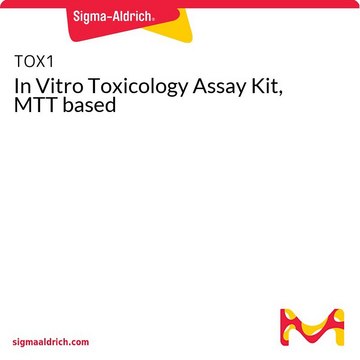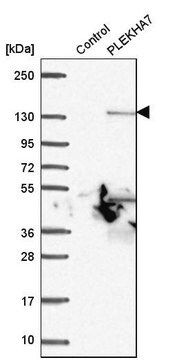CYTODET-RO
Roche
Cytotoxicity Detection KitPLUS (LDH)
sufficient for 400 multiwell tests (04744926001), sufficient for 2,000 multiwell tests (04744934001), kit of 1 (4 components), suitable for protein quantification, suitable for cell analysis, detection
로그인조직 및 계약 가격 보기
모든 사진(2)
About This Item
UNSPSC 코드:
12352200
NACRES:
NA.55
추천 제품
양식
liquid
Quality Level
사용
sufficient for 2,000 multiwell tests (04744934001)
sufficient for 400 multiwell tests (04744926001)
포장
kit of 1 (4 components)
제조업체/상표
Roche
저장 조건
avoid repeated freeze/thaw cycles
기술
protein quantification: suitable
λmax
490-492 nm
응용 분야
cell analysis
detection
검출 방법
colorimetric
저장 온도
−20°C
일반 설명
Nonradioactive colorimetric assay suitable for high-throughput quantification of cell death and cell lysis, based on the measurement of lactate dehydrogenase (LDH) activity released from the cytosol of damaged cells into the supernatant. The Cytotoxicity Detection KitPLUS (LDH) can be performed in a homogeneous format and requires no transfer and centrifugation steps to separate the supernatant from the cells. The color reaction can be stopped for defined assay conditions.
애플리케이션
- The Cytotoxicity Detection KitPLUS (LDH) is a fast, sensitive, and simple method to quantify cytotoxicity/cytolysis based on the measurement of LDH activity released from damaged cells using the 96-well or 384-well plate format. The kit can be used in many different in vitro cell systems when damage to the plasma membrane occurs. For example: Detection and quantification of cell-mediated cytotoxicity.
- Determination of mediator-induced cytolysis.
- Determination of the cytotoxic potential of compounds in environmental and medical research, and in the food, cosmetic, and pharmaceutical industries.
- Determination of cell death in bioreactors.
특징 및 장점
- Flexible, since the assay can determine the degree of plasma membrane damage in many different in vitro cell systems.
- Safe, because the assay does not use radioactive isotopes.
- Accurate, since assay results strongly correlate to the number of lysed cells.
- Sensitive, since the assay can detect even low cell numbers.
- Fast, since assay results can be determined on a multi-well ELISA reader, which allows simultaneous processing of many samples.
- Convenient, since the assay does not require a prelabeling step.
포장
1 kit containing 4 components
- 04744926001 (1 kit containing 4 components)
- 04744934001 (1 kit containing 4 components)
제조 메모
Working solution: Catalyst:
Dissolve the lyophilizate in 1 ml double dist. water for 10 min, then mix thoroughly.
Reaction mixture:
For 100 tests: Shortly before use, mix 250 μl of reconstituted catalyst with 11.25 ml dye solution
For 400 tests: Shortly before use, add the total volume of reconstituted catalyst (1 ml) to the total volume of dye solution (45 ml) and mix well.
Note: In case you observe crystals in “Dye solution”, shake the bottle at least 1 hour at 37 °C. Remaining precipitates will NOT influence the performance.
Note: The precipitates were formed during the freezing of the product. Repeated freezing and thawing should be avoided.
Note: Prepare immediately before use. Do not store the Reaction mixture.
Storage conditions (working solution): The lyophilizate is stable at 2 to 8 °C.
The reconstituted catalyst solution, the dye solution the lysis solution and the stop solution are stable for
Dissolve the lyophilizate in 1 ml double dist. water for 10 min, then mix thoroughly.
Reaction mixture:
For 100 tests: Shortly before use, mix 250 μl of reconstituted catalyst with 11.25 ml dye solution
For 400 tests: Shortly before use, add the total volume of reconstituted catalyst (1 ml) to the total volume of dye solution (45 ml) and mix well.
Note: In case you observe crystals in “Dye solution”, shake the bottle at least 1 hour at 37 °C. Remaining precipitates will NOT influence the performance.
Note: The precipitates were formed during the freezing of the product. Repeated freezing and thawing should be avoided.
Note: Prepare immediately before use. Do not store the Reaction mixture.
Storage conditions (working solution): The lyophilizate is stable at 2 to 8 °C.
The reconstituted catalyst solution, the dye solution the lysis solution and the stop solution are stable for
- Four weeks when stored at 2 to 8 °C
- Two days at 15 to 25 °C
- For long-term storage (up to 3 months), store bottles at -15 to -25 °C.
- Freezing and thawing the solutions up to three times will not significantly reduce their performance. When crystals are seen in Dye solution, shake the bottle at least one hour at 37 °C. Remaining precipitates will not influence performance. As the precipitates can be formed during freezing of the product, repeated freezing and thawing should be avoided.
기타 정보
For life science research only. Not for use in diagnostic procedures.
키트 구성품 전용
제품 번호
설명
- Catalyst (Diaphorase/NAD+ mixture)
- Dye Solution (INT and sodium lactate)
- Lysis Solution
- Stop Solution
관련 제품
신호어
Danger
유해 및 위험 성명서
Hazard Classifications
Aquatic Chronic 3 - Eye Dam. 1 - Met. Corr. 1
Storage Class Code
8B - Non-combustible, corrosive hazardous materials
WGK
WGK 2
Flash Point (°F)
does not flash
Flash Point (°C)
does not flash
Xiang Jun Zeng et al.
Peptides, 30(6), 1144-1152 (2009-05-26)
Apelin, the endogenous ligand of the G protein-coupled APJ receptor, is a peptide mediator with emerging regulatory actions in the heart. We aimed to determine whether the endogenous apelin/APJ system is an intrinsic protective pathway in ischemic/reperfusion injury. A Langendorff
Yuchen Cai et al.
International journal of molecular medicine, 31(4), 904-912 (2013-02-22)
Mammalian target of rapamycin (mTOR) is a serine/threonine protein kinase and a key element in the phosphatidylinositol 3-kinase (PI3K)/protein kinase B (Akt) signaling pathway. Moreover, it is a negative regulator of autophagy and acts as a central regulator in cell
Mariana Malvicini et al.
Oncoimmunology, 1(7), 1038-1047 (2012-11-22)
The use of conventional cytotoxic agents at metronomic schedules, alone or in combination with targeted agents or immunotherapy, is being explored as a promising anticancer strategy. We previously reported a potent antitumor effect of a single low-dose cyclophosphamide and interleukin-12
Nithya Subramanian et al.
Nucleic acid therapeutics, 25(1), 47-52 (2014-12-17)
The miR-17∼92. or oncomiR-1, cluster encodes oncogenic microRNAs (miRNAs), and it also promotes retinoblastoma (RB) tumor formation. Antagomir and miRNA mimics based approaches are widely tried against oncogenic and tumor suppressive miRNAs. Other methods for targeting cancer related miRNAs are
Haibin Liu et al.
The Journal of biological chemistry, 297(2), 100537-100537 (2021-03-17)
The present study aimed to explore specific mechanisms involved in mediating the neuroprotective effects of Smad ubiquitination regulatory factor 2 (Smurf2) in cerebral ischemic injury. A middle cerebral artery occlusion (MCAO) mouse model and an oxygen-glucose deprivation (OGD)-treated neuron model
자사의 과학자팀은 생명 과학, 재료 과학, 화학 합성, 크로마토그래피, 분석 및 기타 많은 영역을 포함한 모든 과학 분야에 경험이 있습니다..
고객지원팀으로 연락바랍니다.








